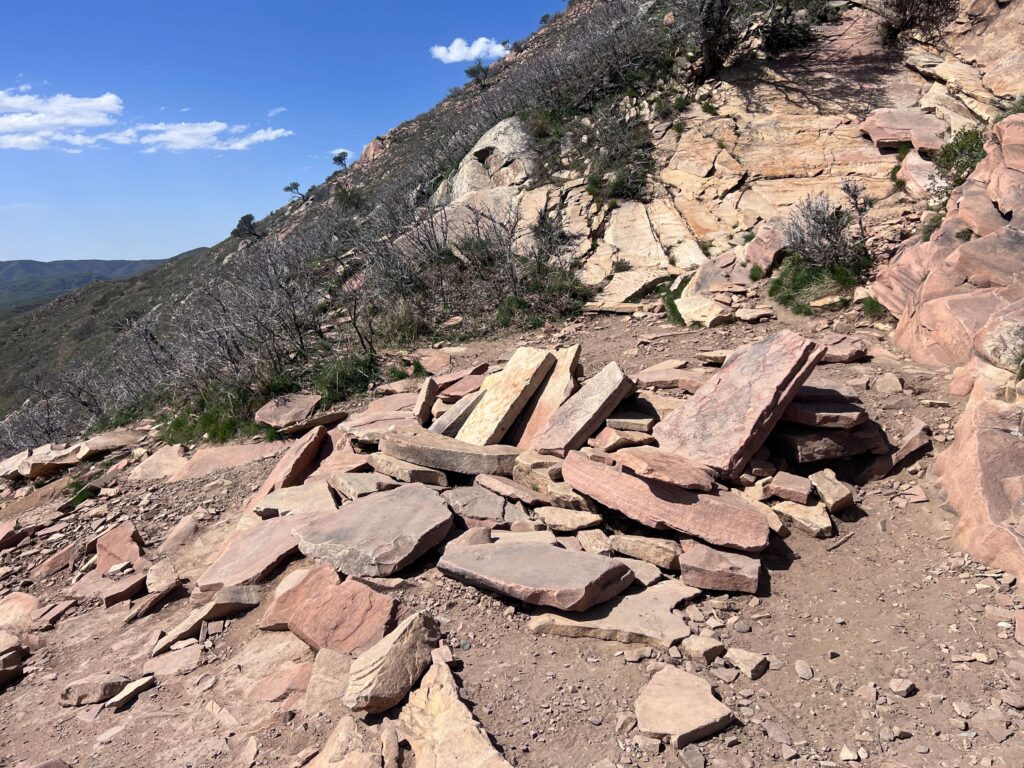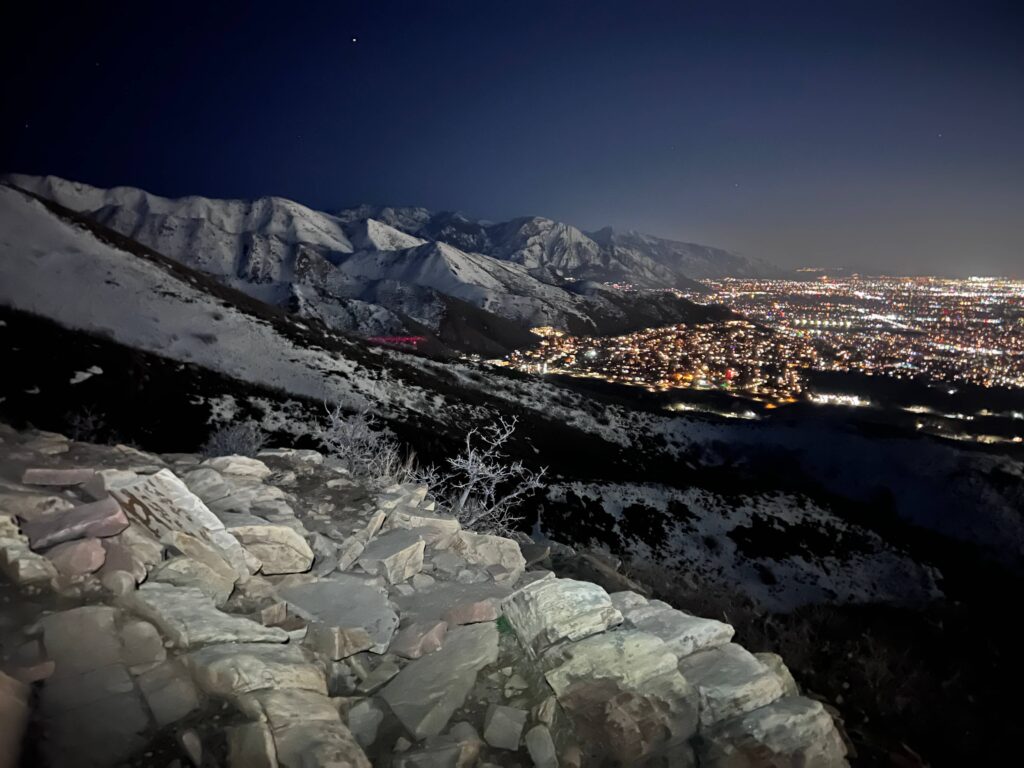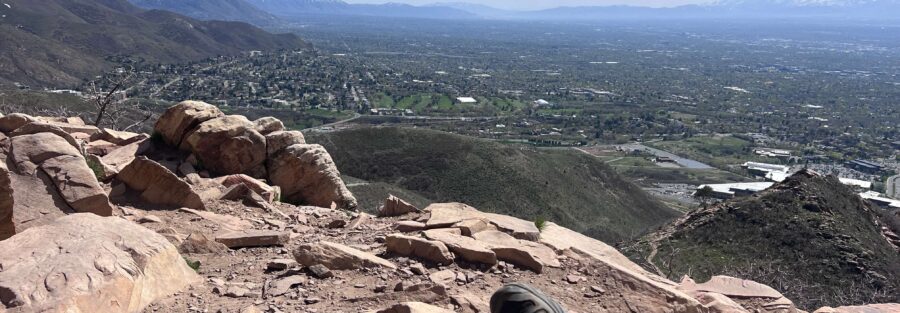Quick Facts:
Location: Salt Lake City, Utah
Coordinates: 40.75947161546912, -111.82121081999145
Length: 2.3 Miles
Difficulty: Moderate
Elevation Gain: 1,000
Dog Friendly: Yes
Introduction:
The Living Room Trail, located in the foothills of Salt Lake City, Utah, is a beloved local hike that offers incredible views of the city skyline and the surrounding mountains. Known for its unique “living room” rock formations at the summit, complete with stone chairs and sofas, this hike is both fun and rewarding. Whether you’re a Salt Lake City resident or a visitor looking for a quick escape into nature, the Living Room Trail provides an accessible adventure with a spectacular payoff.
How to Get There:
The Living Room Trail is conveniently located near the University of Utah, making it easily accessible from downtown Salt Lake City. To reach the trailhead, head east on 400 South, which becomes Foothill Drive. Turn right onto Wakara Way and follow it until you reach Colorow Road. The trailhead is located at the end of Colorow Road, near the Museum of Natural History of Utah. The drive from downtown takes about 10 to 15 minutes, making this hike an ideal choice for a quick outdoor excursion.
Parking Information:
Parking for the Living Room Trail is available along the streets near the trailhead, particularly on Colorow Road and nearby side streets. Be mindful of any parking signs and restrictions, as some areas may have time limits or be reserved for residents. The parking is free, but it can get crowded, especially during peak hiking times like weekends and late afternoons, so arriving early is recommended. There are no official parking lots or facilities at the trailhead, so plan ahead and come prepared.

Description of the Landscape:
The Living Room Trail offers hikers a beautiful and diverse landscape, characteristic of Utah’s foothills. The trail begins with a moderate climb up a series of switchbacks that take you through scrub oak and sagebrush, with occasional views of the valley below. As you ascend, the cityscape of Salt Lake City gradually unfolds beneath you, offering a striking contrast between urban and natural environments.
The trail continues to wind its way up the hillside, becoming rockier as you approach the summit. Along the way, you’ll pass through pockets of wildflowers in the spring and summer, adding color to the otherwise arid landscape. The final stretch of the trail leads you to the “living room” area, where natural rock formations have been arranged to resemble furniture. Here, you can sit back, relax, and enjoy panoramic views of Salt Lake City, the Great Salt Lake, and the Oquirrh Mountains to the west. The sunsets from this vantage point are particularly stunning, making it a favorite spot for evening hikes.
Trail Difficulty and Length:
The Living Room Trail is a moderately challenging hike, suitable for hikers of most skill levels, including families with older children. The trail is approximately 2.3 miles round trip, with an elevation gain of about 980 feet. While the trail is well-marked and maintained, the steady incline and rocky sections can make the hike more strenuous, especially on hot days. Most hikers complete the round trip in about 1.5 to 2 hours, depending on their pace and how long they spend enjoying the views at the summit.
Dog-Friendly Information:
The Living Room Trail is dog-friendly, so you can bring your canine companion along for the adventure. Dogs must be kept on a leash at all times to protect the local wildlife and ensure the safety of other hikers. The trail’s moderate length and shaded sections make it a suitable hike for dogs, but be sure to bring plenty of water, as the exposed sections can get hot, especially in the summer. Always clean up after your dog to keep the trail clean and enjoyable for everyone.

Local Regulations:
When hiking the Living Room Trail, it’s important to follow local regulations to help preserve the natural beauty of the area. Stay on the designated trail to avoid damaging the fragile ecosystem and to prevent erosion. As with all trails in the foothills, practice “Leave No Trace” principles by carrying out all trash, respecting other hikers, and leaving the landscape as you found it. The trail can be busy, especially during peak times, so be courteous and share the trail with others.
Other Trails Nearby:
If you’re looking to explore more of Salt Lake City’s foothills after hiking the Living Room Trail, there are several other trails nearby that offer different experiences. The Red Butte Canyon Trail is a peaceful hike that takes you through a beautiful canyon with opportunities for wildlife viewing. The Bonneville Shoreline Trail is a popular, longer trail that runs parallel to the city and offers various access points for shorter or extended hikes. For a more challenging climb, the Mount Olympus Trail provides a strenuous hike with stunning summit views of the Salt Lake Valley.

Non-Hiking Attractions Nearby:
In addition to hiking, the area around the Living Room Trail offers several attractions that make it a great destination for a full day of exploration. The Natural History Museum of Utah, located near the trailhead, is a must-visit for its fascinating exhibits on Utah’s natural history, geology, and native cultures. The Red Butte Garden is another nearby attraction, offering beautiful botanical gardens and walking paths. If you’re interested in history and culture, the Utah Museum of Fine Arts and University of Utah campus are just a short drive away.
Accommodations: Where To Set Up Basecamp
If you’re looking for modern luxury right in the heart of downtown, the Hyatt Regency Salt Lake City is a top pick. With sweeping mountain views, stylish rooms, and an unbeatable location next to the Salt Palace Convention Center, it’s perfect for both adventurers and business travelers. You can unwind at the rooftop pool, grab a drink at the lively lobby bar, or step outside and find yourself within walking distance of Temple Square, City Creek shopping, and all the best food in town.
👉 Book your stay at Hyatt Regency Salt Lake City here and lock in the best available rates. Every booking through my link helps fuel more Unicorn Adventure road trips and photography journeys!
The Hilton Salt Lake City Center nails that classic downtown vibe with spacious rooms, great on-site dining, and a central location that makes exploring a breeze. Whether you’re catching a Broadway show at Eccles Theater, attending a convention, or heading up into the Wasatch Mountains for a quick hike, this hotel keeps you close to it all. Bonus: the indoor pool and fitness center are perfect for recharging after a long day.
👉 Reserve your room at Hilton Salt Lake City Center here and enjoy exclusive savings. Using my affiliate links directly supports my photography and storytelling while giving you the same great deals.
Best Time to Visit:
The best time to hike the Living Room Trail is during the spring and fall when temperatures are mild, and the trail is at its most enjoyable. Springtime brings blooming wildflowers and lush green vegetation, while fall offers cooler temperatures and the chance to see the changing colors of the leaves. Summer hikes are also popular, but be prepared for the heat and plan to go early in the morning or later in the evening to avoid the midday sun. Winter hikes are possible but may involve navigating snow and ice, especially on the rocky sections of the trail.
Support the Adventure
To make your walls less boring, check out my photography portfolio and bring a piece of the wild and my story into your home.
If you’d like to fuel future adventures, you can donate a coffee on Ko-Fi. Every cup keeps me chasing sunrises and stories.
When you shop using my affiliate links, every click helps support this blog at no extra cost to you. It’s a small way to keep Unicorn Adventure alive and kicking while I keep exploring.
Subscribe to my mailing list for future updates, new stories, and behind-the-scenes adventures.
Stay connected with me on Instagram and Facebook for more photos and daily inspiration.
Thanks for being part of the journey, Unicorn Squadron!


